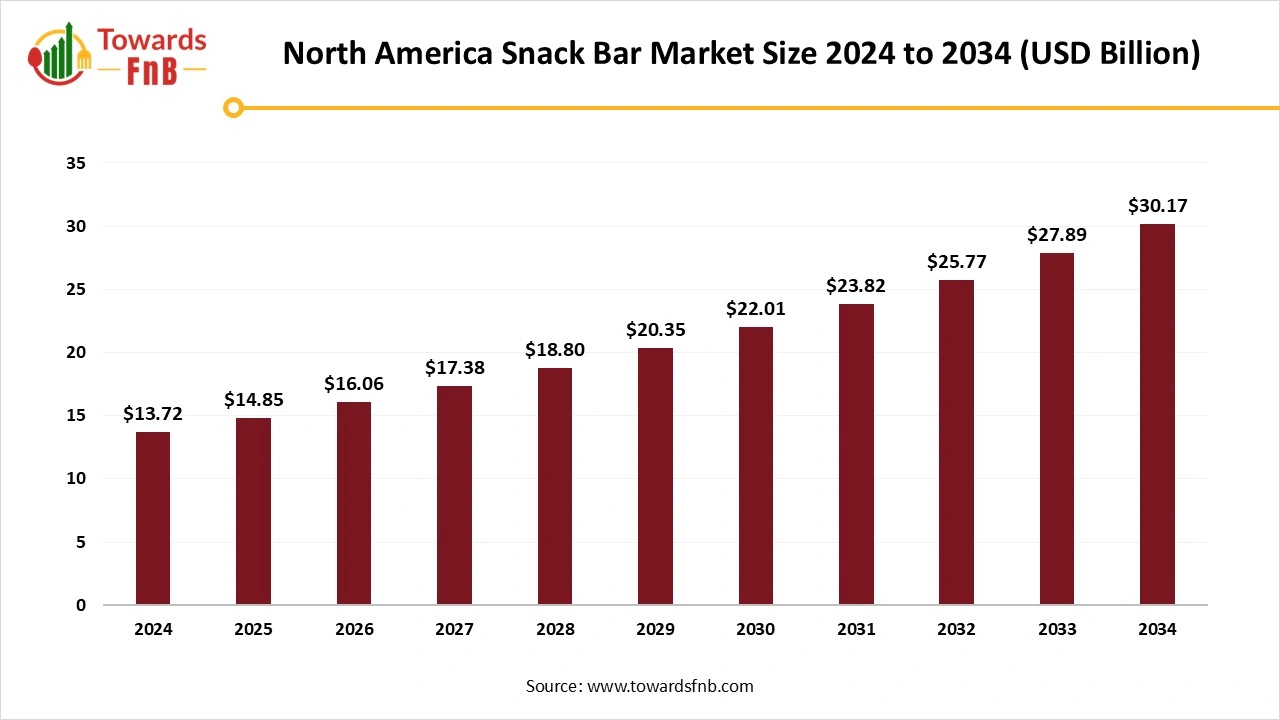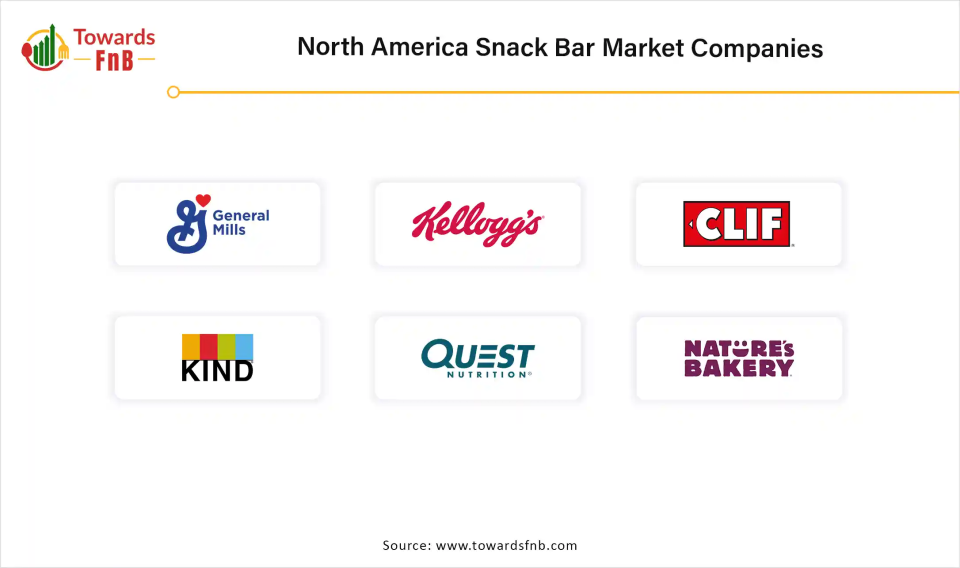December 2025
The North America snack bar market size was calculated at USD 13.72 billion in 2024 and is projected to grow from USD 14.85 billion in 2025 to approximately USD 30.17 billion by 2034, registering a CAGR of 8.2% during the forecast period from 2025 to 2034. Demand of healthy and convenient snacking option due to busy lifestyle rising the demand of snack bar in North America.

| Study Coverage | Details |
| Growth Rate from 2025 to 2034 | CAGR of 8.2% |
| Market Size in 2025 | USD 14.85 Billion |
| Market Size in 2026 | USD 16.06 Billion |
| Market Size by 2034 | USD 30.17 Billion |
| Base Year | 2024 |
| Forecast Period | 2025 to 2034 |
The North America snack bar market refers to the industry involved in the production, distribution, and sale of ready-to-eat snack bars including cereal bars, granola bars, energy/protein bar, meal replacement bars, and others, targeted at health-conscious consumers, fitness enthusiasts, and busy individuals seeking on-the-go nutrition. This market is influenced by changing dietary patterns, rising health awareness, innovation in ingredients and functional benefits, and expanding retail channels across the U.S., Canada, and Mexico.
The snack bar sector has experienced notable expansion and creativity lately, with numerous effective new offerings being launched. Innovation focused on providing new tastes and formats presents a significant opportunity. Specifically, investigating limited-time, travel-themed flavors in smaller formats that enhance permissibility and generate excitement. A broader variety of textures and rich flavors in nutrient-rich, healthier snack and nutrition bars can offer a nourishing snacking experience. Making bars packed with nutrients from diverse grains, cereals, seeds, and nuts can enhance overall health. Brands can revitalize momentum following two years of slow new product development by synchronizing new launches with evolving needs, preferences, and wellness focuses.
High volatile ingredient prices and persistent supply chain challenges could hinder the growth of the North American snack bar industry. Vital raw materials such as seeds, nuts, protein isolates, and dried fruits have experienced notable price volatility due to climate change, farming shortages, and increasing global demand. These obstacles are compelling businesses to either raise product prices or cut profit margins, resulting in premium and organic snack bars becoming less affordable for cost-sensitive shoppers.
United States Dominated the Market in 2024.
The market for snack bars is experiencing significant growth driven by health, lifestyle, and convenience elements. Increased health consciousness among consumers has heightened the demand for nutritious, low-sugar, and high-protein snack choices that promote weight control and active living. The increasing appeal of fitness and wellness trends has further boosted the demand for energy and protein bars. The shift towards urban living and busy lifestyles is driving the need for convenient, ready-to-eat snacks that require no preparation. Generation Z, Millennials, and families with kids (particularly teens) tend to consume snack bars more than once per week. Snack bars are especially favored during breakfast or as a morning treat, with key occasions including satisfying hunger between meals and enjoying while watching TV.
Mexico Expects Significant Growth During the Forecast Period.
Growing health and wellness trends are favorably impacting the market in Mexico. As increasing numbers of individuals recognize the significance of a balanced diet and an active lifestyle, they are looking for snacks that promote energy, fitness, and general health. Functional snack bars, typically loaded with protein, fiber, vitamins, and natural components, fulfill this need by providing health advantages in a convenient format. Major trends in the market encompass the growing demand for clean label and organic snack bars, alongside the launch of unique flavors and ingredients to engage consumers. Industry participants are concentrating on product development, packaging aesthetics, and promotional tactics to set apart their offerings in a competitive market.
Why Energy & Protein Bars Segment Dominated the North America Snack Bar Market in 2024?
Energy & protein bars segment led the North America Snack Bar market in 2024. Consumers increasingly looked for convenient and portable protein options to accommodate their hectic lifestyles and heightened immunity requirements. A shift in snacking choices is expected, with protein bars replacing less nutritious options such as chips, which will further boost this trend. Cargill’s 2025 Protein Profile indicates that 61% of consumers say they are boosting their protein consumption in 2024, an increase from 48% in 2019. Shoppers seek bars that offer significant protein for muscle repair, minimal sugar for weight control, and additional vitamins or natural components for overall wellness, probably fueling market expansion. A search in the USDA FoodData Central reveals more than 2,000 varieties of protein bars available at retailers in the US.
Meal Replacement Bars Segment is Observed to Grow at the Fastest Rate During the Forecast Period.
Due to growing usage in fitness, convenient snacking, and clinical nutrition areas, the meal replacement bars segment is expected to grow. The increasing prevalence of being overweight and obese, along with a range of chronic diseases, has amplified the importance of sustaining a healthy weight and way of life. Individuals are becoming more conscious of their dietary choices and look for convenient and nutritious alternatives that promote better health. Consequently, meal replacement bars are emerging as a favored and practical supplement to the current diet.
Which Ingredients Dominated the North America Snack Bar Market in 2024?
Nuts & seeds segment held the dominating share of the North America snack bar market in 2024. The rising popularity of nuts and seeds is due to heightened consciousness about health and wellness. Consumers are gaining knowledge about the nutritional advantages of nuts and seeds, which are abundant in vital nutrients, protein, healthy fats, vitamins, fiber, and minerals. Almonds, chia seeds, walnuts, flaxseeds, and sunflower seeds, for example, are praised for their benefits to heart health, weight control, and general wellness. Furthermore, growing demand for vegan and plant-based product boosting the demand.
Functional Aaditives (Protein & Probiotics) Segment is Seen to Grow at a Notable Rate During the Predicted Timeframe.
Consumers are more and more drawn to snacks that provide functional health advantages, especially those that include prebiotics and probiotics. This trend is propelled by increasing awareness of digestive health and the importance of the gut microbiome for overall wellness. Consumers are placing greater importance on digestive health in their food selections, driven by an expanding array of scientific studies connecting gut health to general well-being, immune function, and mental health.
Which Flavor Dominated the North America Snack Bar Market in 2024?
Chocolate-based segment dominated the market with the largest share in 2024. Chocolate-flavored snack bars are favored by people of all ages, providing a decadent yet convenient choice for eating on the move. The growing interest in high-quality, dark, and functional chocolates in snack bars, enhanced with protein, fiber, and reduced sugar levels, has fueled demand even more. Moreover, the rise of health-oriented trends has prompted producers to create high-protein, organic, and low-sugar chocolate snack bars, appealing to fitness lovers and health-aware customers. In the United States, 80% of shoppers have bought chocolate confectionery in the last year, motivated by its flavor, convenience, indulgence, and luxury appeal.
Spiced/Herbal Segment is Expected to Grow at the Fastest Rate in the Market During the Forecast Period.
Utilizing spices and herbs can improve the flavor of the snack bar without incorporating extra sugar or salt. Consumers are progressively looking for snack bars that deliver both flavor and nutritional benefits, and herbal and spice flavors can elevate the taste profile of healthy snacks while also presenting possible health advantages. Producers of snack bars utilize natural flavorings like herbs, and spices to develop distinctive flavors. Natural flavorings are favored over artificial ones because they are viewed as healthier and more genuine.
Which Consumer Demographics Held the Largest Share of the North America Snack Bar Market in 2024?
Adults (general consumers) segment held the largest share of the North America snack bar market in 2024. Adults, especially those with hectic routines, consider snack bars a convenient option to curb hunger between meals or while traveling. They are portable and need no preparation, making them a sensible choice for individuals with little time or cooking resources. Almost 50% of adults in the US buy snack bars, with the majority eating them 2-3 times weekly or a few times monthly.
Diet-Specific Consumers (Keto, Vegan) Segment is Observed to Grow at the Fastest Rate During the Forecast Period.
Contemporary shoppers are more health-aware, choosing snacks that provide nutritional advantages while still maintaining flavor. This change is apparent in the growing preference for protein-rich choices, plant-based snacks, and items featuring clean labels devoid of synthetic additives and preservatives. This expansion is fueled by heightened consumer recognition of the keto diet's advantages for weight control and general well-being, alongside the growing need for convenient and tasty choices that fit this eating plan.
Which Distribution Channel Dominated the North America Snack Bar Market in 2024?
Supermarkets/hypermarkets segment led the market in 2024. These major retailers provide an extensive range of snack bar brands and varieties, addressing various consumer tastes and dietary requirements. This dominance also applies to the snack bar segment, as leading chains broaden their selections to feature both national brands and private label choices. In North America, major companies in the snack bar market include supermarkets and hypermarkets such as Walmart, Kroger, Sprouts, and Meijer, allocating shelves and cabinets to these products. Customers favor supermarkets and hypermarkets because they offer a wide variety of products in a single place, including drinks, fresh produce, snack options, and other grocery items. During their regular shopping visits, shoppers are motivated to purchase snack bars due to their ease of use.
Online Retail/E-commerce Segment is Seen to Grow at a Notable Rate During the Predicted Timeframe.
E-commerce platforms are becoming more popular, providing a convenient way to buy snack bars directly from manufacturers or via online marketplaces. This trend offers manufacturers the chance to interact directly with consumers and optimize distribution. Convenience and availability propel online sales channels, aiding the growth of the market as consumers prefer ordering directly from brands or large e-commerce sites.
How Single-serve Bars Segment Dominated the North America Snack Bar Market in 2024?
Single-serve bars segment dominated the North America snack bar market in 2024. Single-serve packaging meets the demands of students, busy professionals, and commuters who value convenience while ensuring freshness and quality are not sacrificed. Additionally, the growing food delivery and e-commerce industries have heightened the demand for small, lightweight, and tamper-evident packaging, consequently fueling market expansion. A rising trend in sustainable packaging sees brands using recyclable and compostable materials for individual snack bars.
Eco-Friendly Packaging Segment is Expected to Grow at the Fastest Rate in the Market During the Forecast Period.
The fast-changing snack food packaging sector prioritizes sustainability, convenience, and a longer shelf life. The market is experiencing an increase in environmentally friendly packaging as consumers grow more aware of sustainability. This encompasses utilizing resources such as paper and cardboard, compostable plastics, and bio-derived films. Consumers are more frequently attracted to brands that emphasize sustainable packaging, making it an important aspect of buying choices.
Ferrero Group
Once Upon a Farm
One Brands

By Product Type
By Ingredients
By Flavor
By Consumer Demographics
By Distribution Channel
By Packaging Type
December 2025
December 2025
November 2025
November 2025